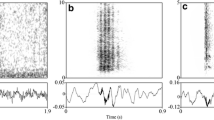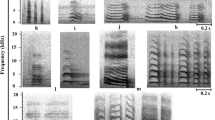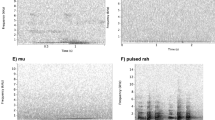Abstract
To advance knowledge of the vocal communication associated with close proximity social interactions in Garnett's greater bush baby (Otolemur garnettii), we measured acoustic and temporal properties of vocalizations from videotaped recordings of captives in two main social contexts: mother-infant interactions and adult male-female pair introductions and reintroductions. We used a real-time sonagraph or software program to display, edit, and analyze vocal waveforms, and to provide wideband and narrowband spectrograms. Vocalization characteristics measured include fundamental frequency (via inspection of harmonics) and spectral features such as formant frequency, intensity, and duration. The vocal repertoire contained 4 major types of vocalizations: 1) barks and complex multiple bark sequences, 2) low frequency flutter/hums and growls, 3) high frequency clicks and spits, and 4) noisy shrieks. We describe several vocalizations for the first time and provide a clear classification of some of them on the basis of call durations (long/short growls). Complex bark sequences, previously described as distant communication calls, were invariant and were not often emitted by individuals when in close proximity. When classified spectrographically, the remaining 3 call types, which occurred when individuals were in close proximity, were less stereotypical, and gradations within call types were apparent. Our results show that although nocturnal and non-gregarious, complex communicatory signals of bush babies constitute a vocal repertoire formerly thought to be characteristic only of diurnal, gregarious primates.
Similar content being viewed by others
References
Andrews, R. J. (1963). The origins and evolution of the calls and facial expressions of the primates. Behaviour 20: 1-109.
Bakeman, R., and Quera, V. (1995). Analyzing Interaction Sequential Analysis, Cambridge University Press, Cambridge, England
Bearder, S. K. (1999). Physical and social diversity among nocturnal primates: A new view based on long term research. Primates 40: 267-282.
Bearder, S. K., Honess, P. E., and Ambrose, L. (1995). Species diversity among galagos with special reference to mate recognition. In Alterman, L., Doyle, G. A., and Izard, M. K. (Eds.), Creatures of the Dark: The Nocturnal Prosimians, Plenum, New York, pp. 331-352
Becker, M. L. (2001). Vocal communication in the small-eared bushbaby (Otolemur garnettii): Morphology, sound structure, and social context (Doctoral dissertation, The University of Memphis, 2000). Diss. Abstr. Int.-B 61(11):, 6169
Becker, M. L., Buder, E. H., and Ward, J. P. (2000). Investigating communicative functions of vocalization patterns in Otolemur garnettii mothers and infants [Abstract] (Special issue). Int. J. Psychol. 35(3–4)
Blount, B. G. (1985). “Girney” vocalizations among Japanese macaque females: Context and function. Primates 26: 424-435.
Borden, G. J., Harris, K. S., and Raphael, L. J. (1994). Speech Science Primer: Physiology, Acoustics, and Perception of Speech, 3rd edn., Williams and Wilkins, Baltimore, MD
Buder, E. H., Becker, M. L., and Ward, J. P. (2000). Zoophonetics: Validating the communicative structure of primate vocalizations [Abstract] (Special issue). Int. J. Psychol 35(3–4): 142.
Cheney, D. L., and Seyfarth, R. M. (1996). Function and intention in the calls of non-human primates. Proc. Br. Acad. 88: 59-76.
Cherry, J. A., Izard, M. K., and Simons, E. L. (1987). Description of ultrasonic vocalizations of the mouse lemur (Microcebus murinus) and the fat-tailed dwarf lemur (Cheirogaleus medius). Am. J. Primatol. 13: 181-185
Drubbel, R. V., and Gautier, J.-P. (1993). On the occurrence of nocturnal and diurnal loud calls, differing in structure and duration, in red howlers (Alouatta seniculus) of French Guyana. Folia Primatol. 60: 195-209
Eisenman, L. M. (1978). Vocal communication in primates. In Noback, C. R. (ed.), Sensory Systems of Primates, Plenum, New York, pp. 93-108.
Hammerschmidt, K., and Fischer, J. (1998). The vocal repertoire of barbary macaques: A quantitative analysis of a graded signal system. Ethology 104: 203-216.
Hammerschmidt, K., and Todt, D. (1995). Individual differences in vocalizations of young barbary macaques (Macaca sylvanus): A multi-parametric analysis to identify critical cues in acoustic signaling. Behaviour 132: 381-399
Harcourt, A. H., Stewart, K. J., and Hauser, M. (1993). Functions of wild gorilla ‘close’ calls. I. Repertoire, context, and interspecific comparison. Behaviour 124: 89-122.
Kay Elemetrics. (1988). DSP Sona-Graph Model 5500, Day Elemetrics Corp., Pine Brook, NJ
Macedonia, J. M., and Stanger, K. F. (1994). Phylogeny of the Lemuridae revisited: Evidence from communication signals. Folia Primatol. 63: 1-43.
Marler, P. (1965). Communication in mankeys and apes. In Devore, I. (ed.), Primate Behavior: Field Studies of Monkeys and Apes, Holt, Rinehart, & Winston, New York, pp. 544-584
Marler, P. (1970). Vocalizations of east African monkeys. Folia Primatol. 13: 81-91.
Marler, P. (1972). Vocalizations of east African monkeys II: Black and white colobus. Behaviour 42: 175-197.
Marler, P. (1977). The structure of animal communication sounds. In Bullock, T. H. (ed.), Recognition of Complex Acoustic Signals, Verlag Chemie, Weingein/Bergstr, pp. 17-35.
Martin, R. D. (1990). Primate Origins and Evolution: A Phylogenetic Reconstruction, Princeton University Press, Princeton.
Masters, J. C. (1991). Loud calls of Galago crassicaudatus and G. garnettii and their relation to habitat structure. Primates 32: 153-167
Milenkovic, P. (2000). TF32 [Computer software], University of Wisconsin-Madison, Madison, WI
Mitani, J. C., and Stuht, J. (1998). The evolution of nonhuman primate loud calls: Acoustic adaptation for long-distance transmission. Primates 39: 171-182.
Muroyama, Y., and Thierry, B. (1998). Species differences of male loud calls and their perception in Sulawesi macaques. Primates 39: 115-126.
Nash, L. T., Bearder, S. K., and Olson, T. R. (1989). Synopsis of Galago species characteristics. Int. J. Primatol. 10: 57-79
Newman, J. D., Smith, H. J., and Talmage-Riggs, G. (1983). Structural variability in primate vocalizations and its functional significance: An analysis of squirrel monkey chuck calls. Folia Primatol. 40: 114-124.
Oates, J. F., and Trocco, T. F. (1983). Taxonomy and phylogeny of black-and-white colobus monkeys: Inferences from an analysis of loud call variation. Folia Primatol. 40: 83-113.
Ohala, J. J. (1983). Cross-language use of pitch: An ethological view. Phonetica 40: 1-18.
Owren, M. J., and Rendall, D. (2001). Sound on the rebound: Bringing form and function back to the forefront in understanding nonhuman primate vocal signaling. Evol. Anthropol. 10: 58-71.
Pariente, G. (1979). The role of vision in prosimian behavior. In Doyle, G. A., and Martin, R. D. (Eds.), The Study of Prosimian Behavior, Academic Press, New York, pp. 411-459
Petter, J. J., and Charles-Dominique, P. (1979). Vocal communication in prosimians. In Doyle, G. A., and Martin, R. D. (Eds.), The Study of Prosimian Behavior, Academic Press, New York, pp. 247-305.
Riede, T., Herzel, H., Mehwald, D., Seidner, W., Trumler, E., Böhme, G., and Tembrock, G. (2000). Nonlinear phenomena in the natural howling of a dog-wolf mix. J. Acoust. Soc. Am. 108: 1435-1442.
Seyfarth, R. M., and Cheney, D. L. (1997). Behavioral mechanisms underlying vocal communication in non-human primates. Anim. Learn. Behav. 25: 249-267.
Tandy, J. M. (1976). Communication in Galago crassicaudatus. Primates 17: 513-526
Waser, P. M. (1975). Experimental playbacks show vocal mediation of intergroup avoidance in a forest monkey. Nature 255: 56-58.
Whitehead, J. M. (1987). Vocally mediated reciprocity between neighbouring groups of mantled howling monkeys, Alouatta palliata palliata. Anim. Behav. 35: 1615-1627
Wilden, I., Herzel, H., Peters, G., and Tembrock, G. (1998). Subharmonics, biphonation, deterministic chaos in mammal vocalization. Bioacoustics 9: 171-196.
Zimmermann, E. (1985a). The vocal repertoire of the adult Senegal bushbaby (Galago senegalensis senegalensis). Behaviour 94: 213-233
Zimmermann, E. (1985). Vocalizations and associated behaviours in adult slow loris (Nycticebus coucang). Folia Primatol. 44: 52-64
Zimmermann, E. (1989). Aspects of reproduction and behavioral and vocal development in senegal bushbabies (Galago senegalensis). Int. J. Primatol. 10: 1-16
Zimmermann, E. (1990). Differentiation of vocalizations in bushbabies (Galaginae, Prosimiae, Primates) and the significance for assessing phylogenetic relationships. Z. Zool. Syst. Evolut.-Forsch. 28: 217-239.
Zimmermann, E. (1995). Loud calls in nocturnal prosimians: Structure, evolution, and ontogeny. In Zimmermann, E., Newman, J. D., and Jürgens, U. (Eds.), Current Topics in Primate Vocal Communication, Plenum, New York, pp. 47-72.
Zimmermann, E., Bearder, S. K., Doyle, G. A., and Andersson, A. B. (1988). Variations in vocal patterns of Senegal and South African lesser bushbabies and their implications for taxonomic relationships. Folia Primatol. 51: 87-105.
Author information
Authors and Affiliations
Rights and permissions
About this article
Cite this article
Becker, M.L., Buder, E.H. & Ward, J.P. Spectrographic Description of Vocalizations in Captive Otolemur garnettii . International Journal of Primatology 24, 415–446 (2003). https://doi.org/10.1023/A:1023013619714
Issue Date:
DOI: https://doi.org/10.1023/A:1023013619714




